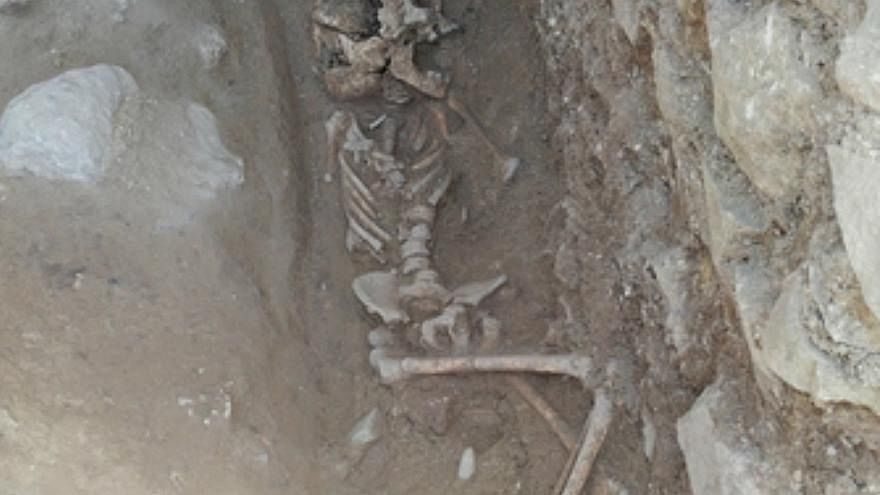Dread Fear of the Unknown
"We know that this kind of unusual treatment usually indicates a fear of the undead, specifically, a fear that the dead might come back from the grave to continue to spread diseases to the living."
"Placing the stone in the child's mouth is a literal or symbolic way of incapacitating them."
"It's something that I thought a lot of while we were working on this project. It seems when humans are faced with the unknown, it's been a very common reaction throughout our entire history to react with fear."
"I really feel deeply for this community that was dealing with this epidemic when they had no understanding of it."
Jordan Wilson, bioarchaeologist, doctoral student, University of Arizona
"It must have been a situation where you don't know what's happening, you have no idea ... where you're almost trying anything in desperation and listening to whoever can come up with an answer."
"It's just genuinely eerie."
"They're sprinkling honeysuckle all over the place. There's all these magic rites that are going on around this, which makes this cemetery so fascinating."
Dr. David Soren, University of Arizona regents professor
 |
A rock was inserted into the mouth of a 10-year-old
to keep the deceased child from rising from the grave and spreading
malaria, researchers believe. (Photo courtesy of David Pickel/Stanford
University)
|
The site is La Necropoli dei Bambino (Cemetery of the Babies), now abandoned, once a Roman villa turned into a massive graveyard for children somewhere around the middle of the fifth Century, where in Lugnano, Italy, the community hesitated between its pagan heritage and Christianity. The people were frozen in fear and horror, assailed by mounting deaths that seemed to have no explanation in their living memory, causing them to return to witchcraft, to bury children with fearful rituals.
Within that once-sprawling Roman villa was found yet another miniature tomb, holding the skeleton of a ten-year-old who lived and died over 1,500 years earlier. The skeleton of the child lies on its side, mouth open, stuffed with a limestone rock, the size of an egg. Scientists believe the child died of malaria in a viral outbreak that converged on the fifth-century community once living in this tiny medieval hilltown, some 60 miles north of Rome.
A substantial number of these mysterious burials have been found, leading archaeologists to term them "vampire burials", where people of the era, terrified that those that had died of mysterious maladies might awaken from death to move among the living and cause them in turn to die drove them to desperate action. So they buried children with stones in their mouths, an ancient ritual meant to keep the child from rising and going on to spread the deadly malady.
During that era, people confronted with dread diseases they had no previous experience with, and with no idea how to confront the cause, resorted to superstition and witchcraft in hopes of preventing the spread of a deadly disease. Further theories connect the transmission of such diseases, leaving survivors in a state of panic and overwhelming fear, with the Roman Empire's demise, extending that theory beyond, to the Attila the Hun scourge, stopped from full invasion of Italy.
The site was first revealed to Dr. Soren in 1987 when he had been at work on an entirely different project on the isle of Cyprus. At that time he had been invited to come to Lugnano in the Umbria region of Italy which was the very centre during the Roman Empire era, of practised witchcraft, and while there he encountered the remnants of the Roman villa, roughly the size of a shopping mall. There, was discovered what remained of a pyramid-shaped dining room representing slaves' quarters.
There they also discovered the remains of infants, toddlers and aborted fetuses buried along with raven talons, toad bones, ash-filled bronze cauldrons, and puppies that had been sacrificed ritually. The name that archaeologist have for such sites is "deviant burials" representing the ancient ritual of burying people feared to be in possession of supernatural powers such as returning from the dead; alternately those who violated the rules of society.
The remains of 51 children buried in such manner, uncovered by Dr. Soren and his archaeological team were seen through biomolecular tests to have perished from malaria, along with fetuses scientists believe were doomed with the disease even before birth. The ten-year-old most recently discovered last week, was the oldest of such children so far discovered. Beside that skeleton was that of a three-year-old whose hands and feet were weighted with stones; another vampire burial.
 |
| The body of a 10-year-old child was found over the summer with a rock in its mouth. Researchers are calling it a "vampire burial." (Photo: David Pickel, Stanford University) |
Labels: Disease, Medieval Era, Superstition, Witchcraft

0 Comments:
Post a Comment
<< Home